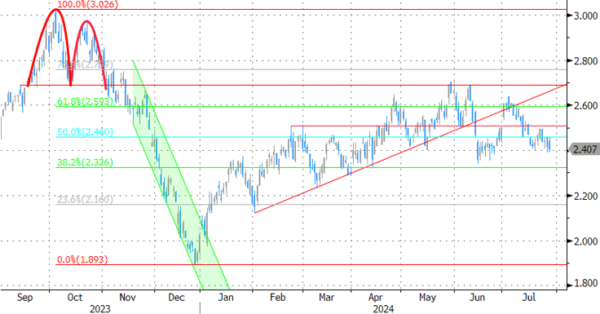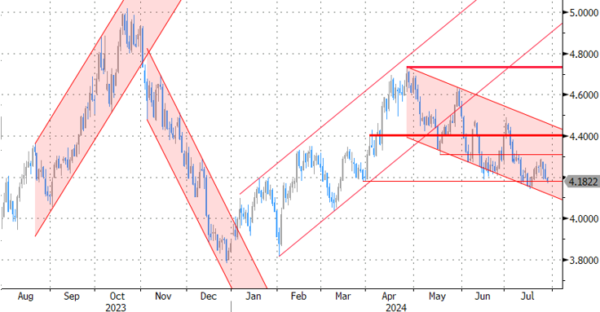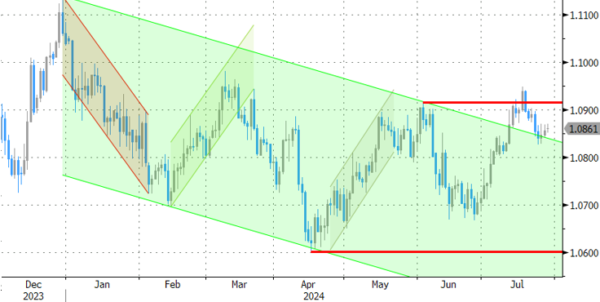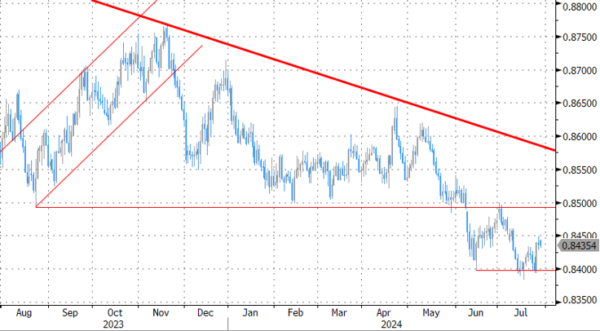Markets
Core bonds finished higher last Friday. US Treasury yields were unable to build on Thursday’s Q2 GDP intraday rebound. The release of some economic data including personal income & spending and June PCE deflators wouldn’t call for a net daily yield decline between 3.1 and 5.6 bps but yet that’s exactly what happened. It suggests that going into a busy week and even after a sharp correction already, the downside in yields remained vulnerable. German yields ended the day marginally lower by less than 2 bps across the curve. Stock markets caught a breather. Technical support areas (5400 zone in S&P500, 4840 zone in EuroStoXX50) lived up to the name. Europe and Wall Street easily ended more than 1% higher. The US dollar traded mixed to slightly weaker. EUR/USD as a result finished a bit higher, into the northern 1.08-1.09 half. After an impressive comeback, Japan’s yen traded near the recent highs against the dollar (USD/JPY 153.76) and the euro (166.93). Sterling rebalanced after Thursday’s sharp drop lower. EUR/GBP tested 0.845 but eventually closed virtually unchanged around 0.8437. Cable (GBP/USD) snapped a three-day losing streak, eking out a slight gain to 1.2867. UK yields followed the global example south. The 2-yr yield hit a new YtD low ahead of the Bank of England meeting later this week.
Asian equity markets kick of the week in good spirits, following the US example end last week. Japan outperforms regional peers, rising more than 2%, unbothered by the Gaza war over the weekend escalating. Israel blamed Hezbollah for a rocket explosion in the Israeli-occupied Golan Heights that killed several youngers during a soccer game. Israel retaliated on Sunday but kept the door open for diplomacy. The eco calendar is a meagre one today and its backloaded nature could keep markets on the sidelines of the trading arena. Things get interesting from tomorrow on with European Q2 GDP and national (Germany, Spain, Belgium) inflation numbers due ahead of the European figure on Wednesday. Both the Bank of Japan and the Fed have their policy meeting on Wednesday with the Bank of England’s knife-edge decision due a day later. Friday is centered around US payrolls.
News & Views
Seeking to be better prepared for a potential next term, EU officials are developing a two-step trade strategy to deal with Donald Trump and the Republicans after the November elections. The former president has already floated the idea of a 10% minimum tariff on all imports, which the EU estimates could reduce exports to the US by around €150bn annually. The bloc’s negotiators plan to approach Trump and his team before he takes office and will discuss with US products the EU could buy in larger amounts. If that fails, the EC trade department is drawing up a list of imports on which it could smack 50% or more tariffs. The carrot-and-stick approach follows after Trump in his first presidency oversaw an import levy on €6.4bn of steel and aluminium, which was then countered by the EU by tariffs of a value of less than €3bn.
G20 finance chiefs last Friday concluded a two-day meeting with a joint statement expressing increasing hopes for a soft landing of the global economy. But there are a number of risks, including wars and escalating conflicts, that could endanger this outlook. It called for more global cooperation instead and to resist protectionism as well as stressed the need to reduce economic inequalities. The communique also first the time ever argued for cooperation to effectively tax the world’s largest fortunes though it has not been agreed on how to move further from this. The G20 chiefs assessed economic risks as broadly balanced with more economic cooperation, faster-than-expected disinflation and technological innovation including AI offsetting downside risks coming from the latter, as well as economic fragmentation, climate change, excessive debt and higher-for-longer rates.
Graphs
GE 10y yield
The ECB cut its key policy rates by 25 bps at the June policy meeting. A more bumpy inflation path in H2 2024, the EMU economy gradually regaining traction and the Fed’s higher for longer US strategy make follow-up moves difficult. Markets are coming to terms with that. Disappointing US and unconvincing EMU data, however, for now brings yields back to their post-French snap election low. The 2.34%-2.4% support zone looks solid.
US 10y yield
The Fed indicated that it needs more evidence to lower its policy rate. June dots suggested one move in 2024 and four next year. Disappointing ISM and back-to-back downward CPI surprises put the US money market back on more than two rate cuts this year (September/December). The US 10-yr yield tests the recent lows and the downside of the downward trend channel in the 4.2% area.
EUR/USD
EUR/USD tested the topside of the 1.06-1.09 range as the dollar lost interest rate support at stealth pace. Markets consider a September rate cut a done deal and only need confirmation from high-ranked Fed officials. In the meantime, the euro got rid of the (French) political risk premium. EUR/USD recently evolved back to a more neutral positioning but is holding up rather well despite ongoing poor EMU data.
EUR/GBP
Debate at the BOE is focused at the timing of rate cuts. May headline inflation returned to 2%, but core measures weren’t in line with inflation sustainably returning to target any time soon. Still some BoE members at the June meeting appeared moving closer to a rate cut. Labour has yet to reveal its policy plans after securing a landslide election victory. EUR/GBP 0.84 support is being tested.
















